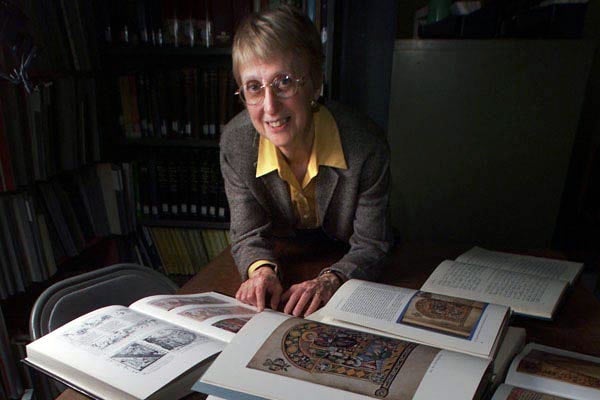
Dictionary of Old English: "a great Canadian enterprise"
Published: January 22, 2013
Goldfinger: the word conjures up images of gold-smothered women, razor-hatted henchmen and giant lasers.
It’s the title of the quintessential James Bond story and reflects perfectly the villain’s obsession with the precious metal. But it’s unlikely that Bond creator Ian Fleming was aware of the fanciful title’s rather pedestrian etymology.
The word dates back to the Middle Ages and “refers to the fourth or ring finger,” explains Antonette diPaolo Healey, lexicographer extraordinaire and editor of the Dictionary of Old English (DOE).
Professor Healey’s office is tucked away in a warren of rooms on the 14th floor of Robarts Library, the shelves around her are overstuffed with copies of manuscripts, texts and tomes of varying description representing the entirety of the Old English language.
Sponsored by the Centre for Medieval Studies, the DOE is a decades-long project to identify and define every word in the English language as it was written from CE 600-1150. This will result in some 33,000 to 35,000 individual dictionary entries.
The DOE was started in the ’70s by the late Professor Angus Cameron and exists entirely in electronic form. What sets it apart, however, is its comprehensiveness — the DOE is based on at least one copy of every surviving Old English piece of writing, from Beowulf to the Bible, legal documents to royal records — pretty much anything ever written on parchment, carved in stone or inscribed in jewelry during the Anglo-Saxon period.
“The corpus contains about four-million words, which amounts to about five times the size of the collected works of William Shakespeare,” says Healey, who holds the Angus Cameron Professorship in Old English. She and her team have completed writing more than 60 per cent of the DOE, or roughly 22,000 entries.
When finished, the DOE will join the Middle English Dictionary (CE 1100-1500) and the contemporary Oxford English Dictionary to provide a complete vocabulary of the English language.
If she had a trained staff of four editors, Healey anticipates they can finish writing the DOE in about 11 to 13 years — for the sake of comparison, the completion of the Middle English Dictionary (University of Michigan) took 71 years. As with many scholarly endeavours, funding is a key factor in its progress, and so the Centre for Medieval Studies is in the midst of an ambitious $10-million campaign to complete the DOE.
In this regard, the DOE is coming off a stellar 2012. The project had already received a $500,000 Challenge Grant from the Andrew W. Mellon Foundation, which required the DOE to raise a 1:1 match to release funds to the project. This was achieved in December thanks to a generous donation from the Honourable Hal Jackman, a former chancellor of U of T, on behalf of his wife, Maruja. The Jackman gift is the largest single donation the project has ever received.
“As a language major at U of T in the ’50s, Anglo-Saxon was an obligatory course,” says Maruja Jackman, explaining her passion for the DOE. “Most hated it — it was very hard work — but I loved it. I loved the language, the poetry and the prose. However, doing the translations was difficult because the dictionaries at the time were so inadequate for my undergraduate needs. To have had access to something like the DOE would have been a dream come true.”
In a book of essays on the DOE's research, Eric Stanley, the now-retired holder of the Rawlinson and Bosworth Chair of Anglo-Saxon at the University of Oxford, called the DOE “a great Canadian enterprise,” proclaiming that “the New World has come to the aid of the Old” and that the DOE “has the backing of Old English scholars world-wide.”
But the question remains: Why do we need a dictionary of Old English?
It’s a question Healey has encountered countless times, yet she never tires of answering.
“Certainly, the DOE is of interest to scholars of Old and Middle English, to linguists and historians,” she begins. “But most importantly, it catalogues the beginning of the English language, our own language. What the Periodic Table of Elements is to chemistry or the human genome project is to biology, dictionaries are to the humanities. We are mapping our language and our culture. People excitedly go to museums to see the artifacts and relics of our ancestors. The words of Old English are not merely a museum collection of the ‘old bones’ of our vocabulary — they are a part of the living tissue of the language we speak today.”



